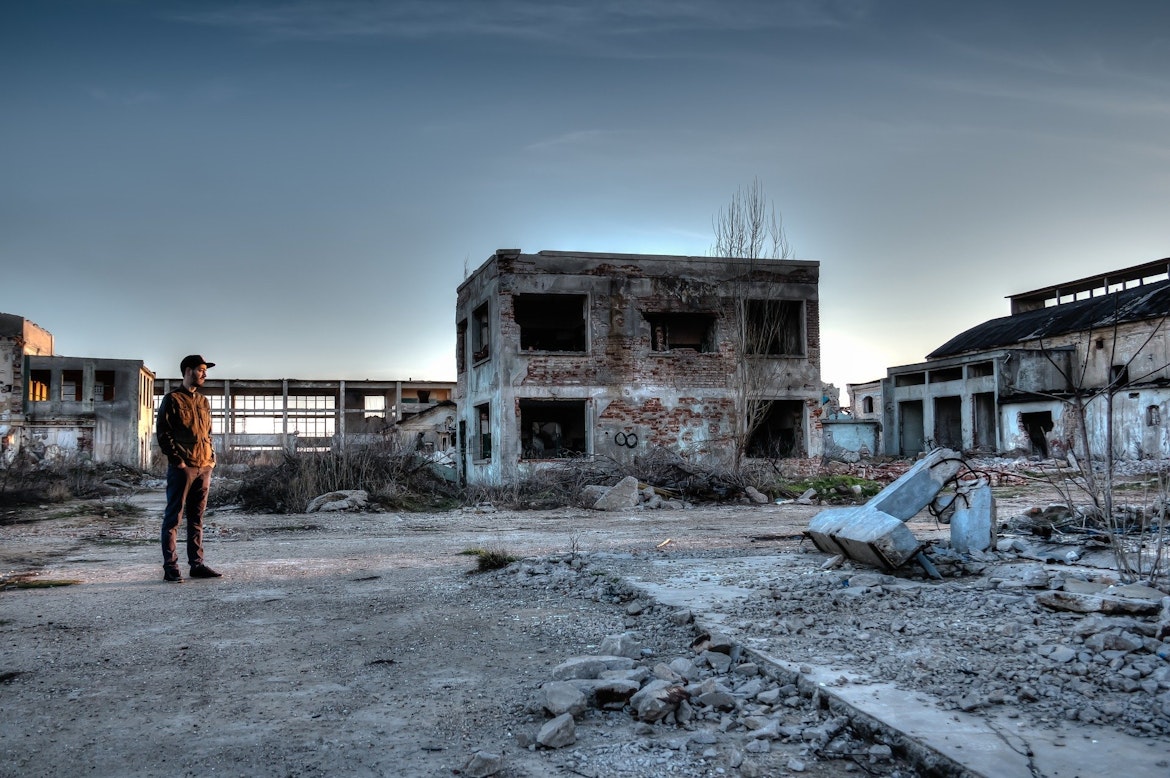Live Free periodically analyzes political, technological, environmental, and economic data to establish the most probable threats to life and freedom. There are a few new ones since the last update in 2011. You have been warned.
As a Certified Hazard Control Manager and experienced student of emergency preparedness methodology, I have written dozens of articles about how to anticipate and prepare for a variety of disaster situations ranging from being lost in the wilderness to being affected by a large scale natural or man-made disaster. I usually take a broader view of disasters than most writers. A disaster is defined by how it affects you and your family. If your house burns down from a misplaced candle or a massive wildfire, it’s still a disaster for you. If you die from a personal ailment or from a pandemic pathogen, you are still dead. Thus, I include home safety, and health issues in most of my threat matrix articles, and I will continue to advocate for good home safety and personal health maintenance as the foundation of survival preparedness. In this article I will focus on the more traditional definition of “disaster”, a wide spread event that has absolute and unfavorable effects on the general population and infrastructure. In comparison to personal disasters where you have more prevention, rescue and recovery potential, these disasters are usually beyond your control to prevent, and you cannot be dependent on external help. My “top ten” probable disasters for this century, based on probability and potential harm are listed below. Note that some are large-scale, cataclysmic events, while others are trends and developments happening now. It is also important to keep in mind that all of these situations negatively affect the probability and the severity of the others.
As a Certified Hazard Control Manager and experienced student of emergency preparedness methodology, I have written dozens of articles about how to anticipate and prepare for a variety of disaster situations ranging from being lost in the wilderness to being affected by a large scale natural or man-made disaster. I usually take a broader view of disasters than most writers. A disaster is defined by how it affects you and your family. If your house burns down from a misplaced candle or a massive wildfire, it’s still a disaster for you. If you die from a personal ailment or from a pandemic pathogen, you are still dead. Thus, I include home safety, and health issues in most of my threat matrix articles, and I will continue to advocate for good home safety and personal health maintenance as the foundation of survival preparedness. In this article I will focus on the more traditional definition of “disaster”, a wide spread event that has absolute and unfavorable effects on the general population and infrastructure. In comparison to personal disasters where you have more prevention, rescue and recovery potential, these disasters are usually beyond your control to prevent, and you cannot be dependent on external help. My “top ten” probable disasters for this century, based on probability and potential harm are listed below. Note that some are large-scale, cataclysmic events, while others are trends and developments happening now. It is also important to keep in mind that all of these situations negatively affect the probability and the severity of the others.
Pandemic #2, #3…
There is no mathematical or logical reason that precludes the probability of another type of pandemic in the next few years. The chances of a pandemic in 2021 are exactly the same as they were in 2019. The same issues of population density, migration and travel that existed before 2020 will exist as we go into the future decades. Unless or until war or pandemic actually reduces the population by a very significant percentage, the threat will remain and grow. No doubt, terrorists and extremists will have noted the effectiveness of this pandemic on America and the West and may work to deliberately develop and distribute even more virulent and deadly pathogens. While we will be more vigilant and better prepared for future pandemics in the near future, apathy and the demands of other priorities will inevitably degrade preparedness over the coming years. Other pathogens may have entirely different pathologies and require different methods of control and treatment, rendering stocks of equipment from the coronavirus useless. The wise survivor will restock and double stock as if the next pandemic is just around the corner.
Mass Civil Disorder
A certain level of civil disorder were experienced as the pandemic of 2020 progressed. It was difficult to manage and slow the spread of the disease while hold together the economy. Fear and frustration was often exploited by political agitators, criminals and even foreign influences to create division and encourage destructive acts. The internet and social-media facilitated hate and conspiracy theories when reason and analysis were most needed. While the police and fire departments were still able to function, many of their members were debilitated and even killed by the virus. The stress of putting their own families at risk to protect the general public did cause some disruptions and reduction in their capability, but it could be much worse in the future. The anti-police rhetoric and misguided political actions immediately resulted in dramatic increases in violent crime in New York, Chicago and other cities, and the massive economic cost of the pandemic is bound to negatively affect the budgets for police and fire protection in every town and city. Most locations will be hard-pressed to maintain public safety services and equipment after the pandemic, much less improve them to meet future challenges. Trained employees at municipal water, power and sanitary facilities were also affected and in some cases threatened to walk-off the jobs if not given extra pay and protection. The food supply chain sputtered and showed signs of failure as transportation, packing and retail employees became ill due to increased exposure. The failure of one or more survival critical services to high-density urban and suburban regions for more than a few days would lead to panic, looting and general lawlessness. Civil disorder in one or two major cities could be controlled by the reallocation of resources and the National Guard, but the spread of civil disorder throughout the country would leave citizen lives and property totally unprotected. The damage could leave most regions devastated to the level of the third world. Such a scenario is more likely now than it was just a year ago, so the survivor must not only be able to survive without help, they must also be able to protect their own lives, freedom, and property against malevolent and violent elements.
Economic Collapse
The health of an economy is determined by its productivity. When the people are able to produce what is needed and purchase what they need we have a stable economy. Even before the pandemic the world economy was a house of cards, only sustained by automation and economic manipulation. The stability of national economies can be measured by the national debt vs the nations productivity (GDP). Here are some examples China has a 1.6 trillion dollar debt with a 297 percent debt vs GDP gap. The US has a whopping 25 trillion dollar debt* with a 106.2 percent GDP gap. Japan has a 12.2 trillion dollar debt against a 237 percent gap. Simply put the world owes more than it can pay and does not have the natural resources to support seven-billion people in anything like health and comfort. Automation has made simple labor less and less valuable and shifted wealth and power to a smaller and smaller number of nations and individuals. While the pandemic practically stopped the production of real produced wealth, trillions dollars in paper wealth were printed and distributed. Less than nine-percent of the worlds wealth exists in any solid (gold, paper) form the remaining ninety-one percent is just ones and zero in computers that has value only as long as people believe it has value. Ultimately the gap (canyon) between our economic illusion and economic reality must lead to a very traumatic adjustment. Sustained depression, massive losses, draconian taxation, high inflation rates, wealth confiscation, and totalitarian government may arise. Gold, diamonds and currency will be worthless, while hard goods and necessities will be the only true currency. Unfortunately: those who have made themselves self-reliant and in possession of needed supplies will be targets of hatred by the public and persecution by the state. Ultimately: only strong networks and alliances among self-reliance practitioners and responsible citizens will suffice to preserve life, freedom and property against annihilation.
*The US debt to China is 4.3 Trillion dollars alone
Climate Change
Regardless of the cause, climate change is a reality that must be faced and survived throughout the coming decades. All ten of the worst weather related catastrophes in US history have occurred since 1992 with a steadily increasing frequency and severity. In addition to creating droughts, floods, hurricanes, wildfires, and violent storms, it will exacerbate international conflicts, famines, mass migrations and economic problems throughout the world. The already weakened economies’ of most nations will render it impossible to cope with these disasters. As a result the world’s capacity to support the current and future populations will continue to decline. We can anticipate living in a more meteorologically violent and unpredictable world while we cope with other threats. The survivor must shift life styles and priorities to meet this evolving situation over decades, while also being better prepared to survive more frequent storms, floods, and other local and regional disasters. The ability to evacuate is particularly important for these kinds of threats.
Nuclear War
While there was a briefed relaxation of the potential for a nuclear exchange after the fall of the Soviet Union, that potential has returned, and is even greater today than it was in the 1980’s. Today’s nuclear delivery systems include hypersonic cruise missiles, stealth drones, hypersonic reentry warheads, and multiple warhead ballistic missiles. The new Chinese Dong-feng 41 missile has a range of 9,400 miles and speed of 25 times the speed of sound. The new weapons are unstoppable and can reach any point in the US within thirty-minutes of launch. Current estimates are that China has 280 warheads, Russia has 6,850, and the US has 6,450, and it only takes one to start Armageddon. In addition, we have India, Pakistan, Israel, North Korea, France and Great Brittan in possession of nuclear weapons that could be accidentally or deliberately detonated or stolen by terrorists. Famines, pandemics, disputes over dwindling resources, and general political instability could easily result in an escalating nuclear exchange. While blast sheltering may be impractical, the ability to evacuate and to detect and survive fallout are still important survival skills. Any significant nuclear exchange would trigger all of the other listed disasters.
Famine
California, one of the world richest food producing areas, has lost over 30 percent of its cropland due to the ongoing drought. The major aquafers that supply the water for crops in Africa, India and the American Midwest are drying up. Food shortages brought riots to Africa in 2010-2011 and food shortages had a part in the disastrous “Arab Spring” movement that eventually generated ISIS. At this point the earth hosts over 7.3 billion people and this number will reach 9.7 billion by 2050 with the global demand for food rising by 50 percent above current levels. America loses one-percent or more of farmland to development annually. By the end of the twenty-first century (if we get there) the population will top 15 billion. To imagine that food production will ever be able to keep up with this demand is preposterous. We cannot even feed the current population in many countries. China’s experiment with food production in Africa has been a total failure. Back in the 1990’s when the Soviet Union collapsed and stopped subsidizing North Korean agriculture over one-million Koreans died within a few years and they continue to die now. The whole world agricultural capacity is fragile and dependent on cheap water, cheap fertilizers (mostly based on petroleum) and cheap fuel to run massive machinery. All of these elements are at or near the breaking point. The pandemic clearly demonstrated the vulnerability of the food distribution system throughout the world. There can be no doubt that the issue of food supplies will become the major political, economic, military, and survival issue in the coming decades. Despotic states and criminal black-market cartels may use food as a weapon to subjugate populations and facilitate oppression. The ability to feed one’s self and one’s family is the foundation of survival and freedom.
Artificial Intelligence Domination
This threat was not seriously on my radar until recently, but must be considered as a threat to human life and freedom as we know it. While computers were first thought to be the means to save us time and improve our lives and social opportunities, the technology has been used to waste our time and prevent intelligent, and productive social interaction. Technology is (intentionally or unintentionally) destroying human society and replacing it with a virtual society controlled by programs and logarithms. China leads the world in thought control and total surveillance of society through facial recognition, intelligent drones, and cameras everywhere, but they are exporting this technology to western nations on a massive scale. I like to call people who have a Pavlovian need to respond to their phone or a text and go about with their smart phone on 24/7 “oblivions” who live in a virtual would rather than the real one around them. It is interesting, and perhaps frightening to note that according to scientific studies human intelligence has been in decline for several decades, while computer power has recently surpassed that of the human brain. Moore’s law states that computer power doubles every 18 to 24 months. Artificial intelligence now engages in so-called “deep learnings” and acts on its own initiatives without human direction. Computers learn and improve exponentially while the human brain improves only linearly. The human brain calculates a bit slower than the speed of light, while quantum computers calculate at thousands of times the speed of light*. Do the math. See the future.
* Due to something called “quantum-entanglement” it is actually possible to calculate and communicate faster than the speed of light.
Cyber Attack, EMP, Grid Failure
Cyber warfare has been in progress between the nations of the world for several decades. Since America is the richest and most cyber dependent nation in the world, it is the major target for all types of cyber-attacks. Targets for cyber-attacks include the electrical power grid, power generation systems, water distribution facilities, sewer systems, medical facilities, police and fire protection agencies, the military, and the financial infrastructure. Artificially intelligent viruses can be programed to travel through the internet, lie in wait and then destroy a system or systems at a given time. Yes, they can be there right now hidden in programs. As with real viruses, computer viruses can be accidentally created and unleashed as well. Such viruses can bypass safety systems to destroy generators, oil refineries, nuclear facilities, water pumps and hospital equipment. An attack on railroad, or air traffic control systems could result in significant death and destruction. Most of the world’s wealth exists as data in computers that could just disappear. Backup systems and air-gapped systems provide some protection, but recent events have demonstrated how these safeguards can be bypassed. Experts estimate that if the electrical grid in the United States was down for ten to twelve months ninety-percent of the population would die from the various affects.
Electromagnetic pulses (EMP) can destroy computers and other electronic devices, if unprotected. A large scale EMP could even disable vehicles, aircraft and municipal service systems. Nuclear weapons generate powerful EMP’s. Solar events can generate EMP’s powerful enough to damage power grids, communication systems and unprotected electronic devices. The military has developed drones and portable devices that can target specific areas with powerful EMPs. Terrorists can probably create EMT weapons as well. The United States, Russia and China are in a race to create the first true quantum computer. Such a computer would make all military and financial computers instantly obsolete and unlock every security system. While an ordinary “super computer” could take many years to try every possible combination of words, letters and numbers in any potential password combination, a quantum computer could try hundreds of billions of combinations in a few minutes.
Cyberwarfare, along with economic warfare, disinformation through social media, drug importation, and political agitation are all part of the asymmetric warfare campaigns being waged against free societies throughout the world. The individual must avoid dependency on personal digital systems and on the infrastructure that depends on them. Backup data to isolated storage, keep hard copies, and keep electronic devices in faraday cages when possible.
Revolution and Civil War
The United States Government is the oldest and most stable government in the world today. All of the governments of Europe, Asia, South America and the Middle-East have fallen and risen several times while the USA has stood and prospered. While many Americans attribute this to our values and the genius of our Constitution there are other factors that have historically contributed to our stability.
- America maintained strong values of community, responsibility, self-reliance and patriotism regardless of race, religion or ethnicity. We were all Americans first.
- While there were natural inequities in wealth distribution they were not nearly as extreme as they are today. A large, contented and socially responsible middle class still existed.
- America and Americans were not subject to the constant divisive and toxic effects of the internet and social media.
None of these stabilizing factors are true today. Multi-ethnic societies are inherently unstable. There is no longer an unlimited amount of real-estate, resources or jobs to absorbed even internal population growth. We are involved with and influenced by divisive and confusing foreign involvements and intrigues. Today’s American is more self-centered, dependency-oriented and less involved in community than any previous generation. The decades of centralized, big government have replaced responsibility with demanding, demonstrating and blame finding. The gap between the poor and the ultra-wealthy is disgraceful and growing. The internet now facilitates division rather than unity, conflict rather than discussion and even violence in place of the political process. Respect for the law and for American values has all but disappeared in many regions. These are harbingers of future revolutionary developments. Armed demonstrations against the pandemic lockdowns and anti-gun legislation is a harbinger of future revolts. The growing sanctuary movement where counties*, and whole states are prepared to defy higher authorities is an indicator of massive discontent and defiance. There is a growing number of religious, racial and political elements that are quietly preparing for such a catastrophe. There is a line in an old movie* about South American revolutions. The General storms into the presidential palace proclaiming “El Presidente, the rebels are in the suburbs!” to which the dictator says “the rebels are always in the suburbs”. We are becoming more like one of these “Banana Republics”
* In Virginia 91 out of the 95 counties passed resolution defying the states gun laws.
Terrorist attacks
While the number of terrorist attacks has temporarily declined, the effects of potential terrorist attacks continues. The cost of “the war on terror” and the massive security measures throughout society has drained hundreds of billions from the national economies that could have been used to rebuild our infrastructure, and reduce our national dept. The terrorists won and continue to win as they affect our lives and our national economy. We can be certain that the recent pandemic has provided terrorist with another weapon to disseminate fear and confusion. Economic challenges will impact the poor and minority communities making them susceptible to radicalization and extremist activities. Economic decline can necessitate cuts in military spending, and the budgets for police and fire protection that may provide opportunities for extremist groups to better organize and plan activities. Criminal gangs and cartels should be included as terrorists, and can be expected to grow in power and audacity as law-and-order weakens. In third world nations the gangs and cartels are the true government, controlling the black-market, and offering safety for a price. Only a vigilant, prepared and armed population can prevent the rise of terror and crime in the future
Conclusion
The possibility of a world-wide disaster can no-longer be in doubt, as one of the above disasters has already occurred and several others are developing as we speak. Each threat scenario affects the probability and potential severity of the others. Some of the above threats occur suddenly, while others develop insidiously over the years. At this point only the most foolish would ignore these threats and fail to make a concerted effort to avoid, mitigate and survive their effects. While it is difficult to predict which one will happen next or in what order such events could occur, but we must all recognize the fragility of our civilization and necessity of constant vigilance and dedicated preparedness.










I’d like to have my email added to your mailing list. Thank you!